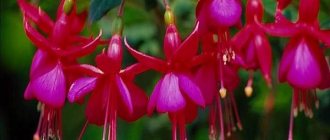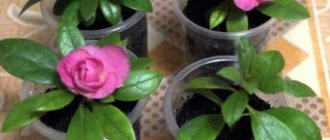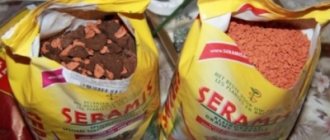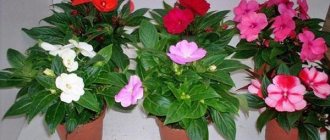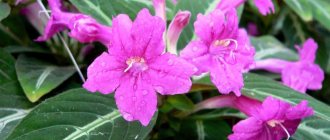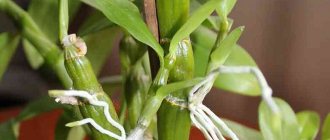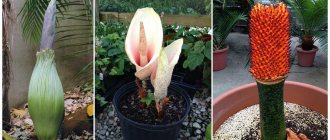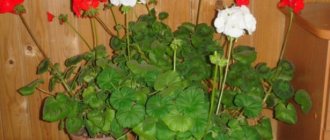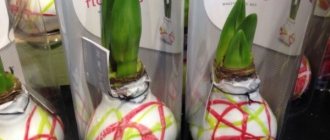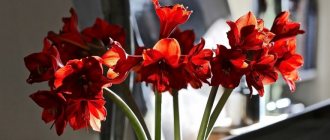Description of the plant and its photo
Impatiens is an ornamental flowering plant that can be grown indoors, on a balcony, veranda or in the yard. Depending on the variety, the plant can be herbaceous or subshrub. Initially, balsam grew in the tropics; the supposed homeland of this flower is the island of Zanzibar. The flower appeared in Europe at the end of the sixteenth century, where cultivated varieties of balsam were bred.
With proper care, balsam blooms almost all year round. The flowers of the plant are large and bright, most often red, but pink, yellow, orange, white, and burgundy are also found. There are varieties with two-color flowers, i.e., a contrasting “eye” in the center of the flower. The leaves are usually dark green, sometimes burgundy or variegated.
Advice! The plant is moisture-loving and requires regular, frequent watering, especially in the warm season. In summer, the balsam should not be exposed to scorching sunlight; it is necessary to shade the plant. In winter, it is not recommended to heavily moisten the soil to avoid hypothermia. Drafts are also detrimental to the flower.
Impatiens do not need to create additional conditions; this flower feels great at the temperature and humidity of an ordinary living space.
Look at the photo of what the balsam looks like:
Humidity and temperature mode
Vanka wet is fully consistent with a tropical plant; it feels great at a temperature of +20...+25ºС, but at the same time it must be provided with fresh air and regular watering. Ventilation is one of the most important rules in care. It requires moderate humidity, but with a significant increase in temperature, it is worth additionally humidifying the air. To do this, you can use containers of water or a special humidifier; the humidity level should not exceed 45-50 units. Spraying is allowed, but it should be done very carefully so as not to get on the flowers and their buds.
Balsam (Vanka wet)
In winter and cool periods, it is worth monitoring the air temperature; it should not be allowed to drop below +10...+15ºС. It is worth remembering that close proximity to heaters can lead to withering of the plant.
Balsam care at home requires careful and attentive care, since even the wrong level of moisture in the room can harm the flower.
Planting seeds and cuttings
Planting balsam is done in two ways:
- Cuttings.
It is considered a simpler way to plant a plant and is recommended for beginning gardeners who want to preserve the quality of the variety. For planting, cuttings obtained after spring pruning of the plant are used. The cut shoot is placed in water until roots appear, this happens after about 2 weeks.After this, the sprout is planted in sand or a substrate prepared from a mixture of peat and perlite in a 2:1 ratio. When the flower gets stronger, it is transplanted into a larger container with regular soil for adult plants.
- Planting seeds.
Used by experienced gardeners and, as a rule, for growing garden varieties. However, it can also be used for indoor plants. It is important to remember that balsam grown from seeds may not have the characteristics of the selected variety. For planting, seeds are placed on the surface of the substrate.It is allowed to slightly deepen the seed, but it is not advisable to sprinkle it on top. After this, the container is covered with film or a glass cap. After about 10 days, sprouts with two leaves appear. This means that the seedlings can be transplanted into separate pots.
You will learn all the details of plant propagation by cuttings and seeds by reading this article.
Breeding rules
These flowers reproduce in two ways - by cuttings and sowing seeds. The most common and effective is cuttings. Experts say that balsam cuttings take root very easily and tolerate adaptation. The main thing is to prepare them correctly, and for this you need to cut off a branch 7-10 cm long from the mother stem, with at least two internodes. The cuttings are placed in moist soil or water. After rooting, they are planted in small pots; peat pots with a diameter of 10 cm can be used. Often, after planting in the spring, a young plant can bloom in the same year.
Sowing seeds is a more labor-intensive task and requires certain knowledge. Growing these flowers from seeds can lead to unexpected results, because maternal characteristics are significantly lost with this method of reproduction.
Wet Roly, like all plants, is susceptible to some diseases, but all of them can only arise if the rules for caring for it are violated. Too high a temperature, lack of moisture, lack of fertilizer - all this can lead to slow growth and wilting, as well as the appearance of harmful insects.
You can get rid of spider mites, aphids and whiteflies using special preparations and following the rules of care.
In general, these points show how to properly care for balsam at home. By observing all the requirements, you can grow a flowering shrub of extraordinary beauty that will delight you with its brightness and grace all year round.
Replanting an indoor flower
It is necessary to replant balsam in order to replace the old depleted soil with new and nutritious soil, as well as to provide additional space for root growth.
At the same time , it is important to remember that some crowding is even beneficial for this flower , since balsam flowering occurs only after the root system fills the space of the pot. If the container is too large, all the energy and nutrients of the balsam will go to the development of roots, and not to flowering.
Transplantation is carried out once a year - in spring, or twice a year - in spring and autumn, depending on the intensity of flower growth. It is also necessary to replant a plant purchased in a store 2 weeks after purchase - this is the time the plant needs to adapt to new conditions. Read about the intricacies of transplanting balsam and its subsequent care here.
Rules of care
When purchasing a flower in a special store, you need to ask what conditions it is used to, how it was watered, and what and when it was fertilized the last time. This information will allow you to properly prepare the environment for optimal adaptation of the new plant.
Many gardeners say that this type of plant is actually unpretentious and requires only regular attention and the right conditions for growth. And the first thing to start with is choosing a place for a flowerpot.
Required soil
This flower requires loose soil with low acidity. An excess of nutrients in the soil is not desirable, as it will lead to the growth of green mass and weak flowering. In a specialized store you can purchase an earthen mixture for flowering plants, or prepare the soil yourself:
- The first option for homemade soil is a mixture of leaf soil, turf, humus, sand and peat in a ratio of 2:2:2:2:1.
- A mixture of leaf soil with peat and river sand (2:1:1) is also used. It is important to remember that all components taken from the street must be disinfected.
Reference! Despite the fact that balsam is very moisture-loving, a thin layer of drainage in the pot is still very desirable. They can serve as small pebbles or pebbles, laid in a layer of no more than 2-3 cm.
Botanical description
The indoor flower Ivan wet grows up to half a meter in height. Its stems are erect, branched, and smooth. The leaves are oval or lanceolate, with small teeth along the edges. Foliage color is purple-bronze or green.
The buds are formed in the axils of the leaves. In cultivation there are varieties with a variety of colors, with the exception of the blue tint. Flowers simple or double. After pollination, green fruits are set; as they ripen, they turn into a dry seed capsule.
Why is the flower called this and what is the correct scientific name? The home flower Vanka wet has other names. All of them are due to the properties of the plant. If you touch a ripe seed pod, it will immediately open the valves and shoot out seeds. For this reason, balsam impatiens was nicknamed “touchy.” Another name – “light” – is associated with bright and abundant flowering.
In reviews, experienced flower growers write that balsam does not tolerate cramped spaces on the windowsill. It grows much better separately, without proximity to other plants.
How to properly care?
Watering
It is extremely important for balsam to receive sufficient moisture. In summer, the flower needs abundant watering, daily or every other day, depending on how quickly the top layer of soil in the pot dries out. Under no circumstances should the soil be allowed to dry out.
In winter, watering is reduced, especially if the plant is in a cool room. Usually, in the cold season, 2 waterings per week are enough for balsam.
Can I spray with water?
Spraying can be carried out if the air in the room is warm and dry. In addition to additional hydration, this procedure serves as a prevention against the appearance of spider mites. Impatiens should be sprayed once every 2-3 days.
After spraying, it is necessary to keep the plant in the shade, since bright sunlight can burn wet leaves.
It is also important to avoid drafts to avoid hypothermia. For the same reason, it is not recommended to spray balsam in winter.
Top dressing
During flowering, balsam requires feeding. Fertilizer should be applied once every 10 days from the beginning of spring to autumn, until the plant enters a dormant period, alternating nitrogen and phosphorus fertilizing. Among organic fertilizers, the main source of nitrogen is bone meal, and phosphorus is wormwood compost.
Nitrogen is necessary for balsam for the successful development of green mass, and phosphorus promotes high-quality flowering. Read about how to properly water and what to feed the plant for abundant flowering here.
How to pinch?
To improve flowering and form a neat bush, in the spring it is necessary to pinch out the balsam, i.e., remove the upper part of the shoot.
Along with pinching, damaged leaves and wilted flowers are usually removed. Thanks to this, the flower maintains a neat appearance, and also reduces the risk of certain diseases and pests.
It is important to remember: pinching is not required for dwarf varieties of balsam.
Trimming
How to prune a plant correctly and when should it be done? Pruning is carried out in March, and young shoots of balsam are cut off, which can be used to propagate the flower. During pruning and pinching, it is necessary to increase watering so that the plant can more easily endure the painful procedures.
How to preserve in winter?
In order for a flower to develop well and bloom actively in the warm season, in winter it is necessary to provide it with a period of rest. This will help the plant rest and gain strength for spring. Receiving less sunlight, balsam can shed its leaves. If proper care is taken, this phenomenon is not a cause for concern.
Lowering the temperature in winter is a desirable, but not necessary condition for balsam. If the plant is placed in cooler conditions during wintering, then you need to remember that the indicator should not be lower than +16 degrees. Watering is gradually reduced from daily to once every 3-4 days.
Accumulation of water in the pan is not allowed. Fertilizers are excluded completely or applied no more than once a month. Nitrogen and phosphorus fertilizers should be replaced with potassium-phosphorus fertilizers.
We wrote in more detail about growing and caring for balsam at home in a separate article.
Why pinch balsam?
Pinching balsams is an important step in growing a flower. The procedure is necessary for:
- ensuring active growth of the bush;
- lush flowering;
- maintaining an aesthetically attractive, neat appearance of the crop.
Attention! There is no need to pinch out dwarf varieties.
Impatiens need to be pinched so that they do not stretch and bloom profusely.
As a result of a simple procedure, the plant becomes branched and neat. Many buds appear on it. During pinching, many gardeners also remove withered leaves and wilted flowers. This is right. Due to this procedure, the balsam releases more new color. In addition, such a step is an excellent prevention of many diseases and pests.
It is recommended to pinch balsams immediately after picking. It is this stage of development of a flowering crop that is characterized by intensive shoot growth. Many seedlings begin to quickly stretch. This is why you should pinch the tops of the plant.
If you restrain the process of stretching and active growth by carrying out such a simple manipulation, you can launch a new mechanism. This is the formation of side shoots. Thanks to them, the balsam becomes like a voluminous, bushy ball. Such a plant looks more attractive and aesthetically pleasing than a fragile, lonely shoot of a painful type.
Scheme for pinching balsam
Possible problems
When growing indoor balsam, you may encounter the following problems:
- The plant does not bloom, in most cases, due to unfavorable factors. Typically, flowering does not occur if the balsam is planted in a pot that is too large, does not receive enough water, or due to excess nitrogen, which it receives from fertilizers.
- Yellowing of the leaves is a signal of a lack of moisture in the soil. In addition, the leaves may turn yellow as a result of a burn if the flower is located in direct sunlight. In winter, this sign indicates hypothermia of the balsam.
Selecting a location
This plant loves sunlight and warmth, so wet Vanka will feel great on the windowsills of the eastern side of the house. But with all his love for light, direct sunlight can harm him; to avoid burns, it is worth slightly shading the windows in the hot summer season. But in winter and cloudy periods, these flowers require additional lighting. If desired, you can use fluorescent lamps; they perfectly imitate natural light. The fact is that extended daylight hours are necessary for this plant; good lighting allows it to bloom throughout the year. It is important to periodically turn the flowerpot with different sides to the sunlight, this will ensure a uniform shape for the shrub.
Diseases and pests
Like many other indoor plants, balsam is susceptible to attack by pests and diseases. The following are considered the most common for this flower:
- The whitefly is an insect dangerous to balsam, appearing in a dry, damp room that does not receive fresh air.
Important! For prevention, regular spraying and ventilation of the room with flowers is necessary. To get rid of whiteflies that have already appeared, use insect repellent tape. - Spider mite - feeds on the sap of balsam leaves, which causes the leaves to wither and curl. It appears, like the whitefly, when the flower is kept in the wrong conditions. Maintaining air humidity and good ventilation will help prevent the appearance of such a pest.
- Soil mold - occurs when there is excess moisture. Despite the fact that balsam is a moisture-loving plant, it is important to ensure that the soil does not sour. If the top part of the soil is still covered with mold, it is necessary to remove the affected layer of soil and fill in a new one.
Rules for watering and feeding
Watering requires Vanka wet, regular and timely. The main indicator for this is the top layer of soil in the flowerpot; as soon as it dries, it is worth watering. Do not let cracks appear and earthen crusts form on the top layer of soil; this can harm the root system. Water with settled and soft water, it is important not to get it on the stem and foliage; it is best if you use a watering can with a thin and narrow spout when watering, this will allow you to carefully pour water along the edge of the pot and not touch the plant. It can go without watering for some time, but this will still affect its growth and flowering duration. Flowers are the first to react to drought; they wither and fall off without sufficient moisture in the soil.
It is worth feeding the flower in spring and summer, approximately once every 14 days, the fact is that Vanka wet does not have a pronounced rest period, it produces young buds even in the cold season. But it still needs fertilizer, since it spends a lot of energy on constant flowering. Therefore, after the buds appear, it is worth adding mineral fertilizers. It is better to provide complementary feeding after watering, when the penetration of liquid or dry preparations is optimal. It is better to use complex fertilizers; they are purchased in special stores or flower salons.
It is important for this plant to periodically loosen the top layer of soil; this will allow oxygen to penetrate to the root system and prevent the occurrence of dampness.
Schefflera care pruning reproduction. How to properly form the crown of a shefflera?
Crown formation is a very important point in the process of growing shefflera. This allows you to give the plant a more aesthetic appearance, stock up on propagation material and maintain the health of the tree. In addition to pruning, you need to periodically pinch out the branches and follow the rules for subsequent care of this southern plant.
Purpose
Many novice gardeners often neglect pruning plants, but in vain. This procedure not only makes it possible to give the bush the desired shape, but also protects it from disease. Schefflera, despite its unpretentiousness, especially needs the timely removal of excess shoots.
Shefflera trimming can be of two types:
- direct formation of the crown - for greater splendor and density of the plant;
- removal of weak, yellowed, dried out, diseased branches.
In order for the plant to begin to branch, you need to cut off the top. Then you will get a lush tree with a dense crown. If you want to form a bush, you need to cut the trunk itself above the bud that has not yet awakened. In this case, the plant will begin to throw out branches throughout the trunk.
In addition, it is necessary to regularly pinch the bush to regulate the length of the lateral shoots.
It is important to choose the right time for such operations. During the dormant period, in winter, the plant does not need to be touched.
This will not only not give the desired result, but may also negatively affect the health of the tree. It is best to wait until spring (March–April), when the plant wakes up and all processes are restored.
Pruning is not just a whim of a gardener who is passionate about his business. This is a necessary operation that must be performed regularly. It performs the following functions:
- allows you to give the plant the desired shape depending on the wishes of the owner;
- promotes the growth of young branches;
- makes it possible to obtain propagation material without harm to the tree itself;
- helps remove damaged or diseased shoots after hibernation.
It is important not to overdo it and not to cut off too much, otherwise, instead of being completely beneficial, the operation may cause harm to the plant. Too long shoots are usually cut off by one third
This is enough to give shape and achieve the desired result.
In addition, pruning a plant, in particular, schefflera, requires compliance with certain rules in order for the process to be the least painful and bring maximum benefit. There are several factors that go into these rules.
- Compliance with the timing of the operation. It is carried out in early spring before the growing season begins.
- The first pruning is carried out after the plant has grown and is more or less formed, strengthened, and accustomed to the conditions. For the first time, 3-4 internodes are cut off on a branch.
- Under no circumstances should you use scissors - only good quality and sharp pruning shears.
- The cuts must be treated with an antiseptic (activated carbon works well), but if the branches are thick, the cut area will need to be covered.
- An adult plant can be cut off at the root (if necessary) - it will not die, on the contrary, it will produce young shoots and grow back.
- To provoke the growth of side shoots to form a round crown, you need to cut the top of the plant into 6-7 internodes.
- To ensure even branching, you need to pinch the ends of the branches.
- After winter it is necessary to carry out sanitary pruning.
Types and varieties of balsam
Waller's impatiens has several names: Waller's impatiens, Waller's balsam, wet weed, impatiens, water fuchsia, sparkle (Impatiens hostii, Impatiens walleriana, Impatiens sultanii). These names refer to one species - Waller's balsam. However, thanks to the work of breeders, many hybrids and varieties of this plant have appeared. All these varieties are similar to each other in their lush and long flowering, relatively long leaf blades (about 12 centimeters) with small teeth along the edge and axillary flowers with five petals.
Below we will describe the groups and varieties of Waller's balsam, which are very popular among gardeners.
Accent F1 Series
The height of miniature bushes varies from 15 to 20 centimeters. Large flowers can be painted in various shades.
Tempo F1 Hybrid Series
The flower has a height of 20–25 centimeters. A characteristic feature of this variety is its early growing season. The flowers can be pink and orange.
Series “Stardust F, Mixed”
The inflorescences are painted in rich colors. Along the edge of the petals there is a border of bright pink, red or coral shade.
Bruno F1 Series
This is the very first series of flowering plants, the set of chromosomes in which is doubled. This variety is resistant to sudden changes in temperature, its flowers are also larger (about 60 mm in diameter), and it is also distinguished by early germination of seed material.
Firefly Series
The compact bush is distinguished by lush flowering. During the flowering period, its lush greenery is hidden by scarlet, purple or peach flowers.
Fiesta F1 Series
The plant is highly branched. Its double rose flowers can be two-colored or single-colored.
Waller's balsam has a hybrid - it is New Guinea balsam. The bush can reach a height of about 0.3 meters. The flowers reach about 70–80 mm in diameter, are solitary and have spurs.
The most widely cultivated varieties of New Guinea balsam are:
Java Series
Bright green leaf blades frame inflorescences of rich “tropical” color.
Series "Jangle Rain"
The flowers are painted in soft pastel colors.
Ideal conditions for growth
Impatiens are good to keep outdoors. If it is not possible to take it out into the garden or onto an open balcony, ventilate the room more often! This recommendation is suitable provided that there is no significant temperature difference between indoors and outdoors. A sharp change in living conditions is detrimental to balsam. Protect from strong gusts of wind - fragile stems and leaves break easily.
Impatiens is a southern plant, and the lack of sun does not have the best effect on it. But you should not keep the flower in too bright sun. The structure of its leaves and stems is quite delicate, so balsam quickly dehydrates and fades. The best conditions: access to the morning sun, but in hot afternoon and afternoon hours it is better to shade the plant.
The ideal temperature for balsam is 20-23 degrees; during the dormant period (winter), the plant should not be kept in a room where it is less than 15 degrees. Balsam is afraid of low temperatures and may die.
Humidity and watering.
Balsam loves abundant watering. In summer, do not allow the soil to dry out even briefly. But, in addition, it needs moist air. Be sure to spray the balsam!
The soil needs to be fertile and loose. Acidity PH 6 -6.5. Composition: turf soil/leaf soil/peat/humus/sand. Everything is in equal parts. Be sure to place drainage made of expanded clay or washed river pebbles at the bottom of the pot.
Temperature: The optimal temperature for Balsam in summer is 20-22°C, and in winter the temperature should not fall below 15 ºC. In too warm rooms, Balsam tends to lose its decorative effect. The plant is afraid of sudden changes in temperature, cold drafts, combustion products, and gas. It is unacceptable to place the plant near heating appliances. In summer, it is recommended to take the plant out into the garden or onto the balcony, but during prolonged rains the plant must be hidden from excess moisture.
Lighting: Requires bright, diffused lighting. A western or eastern window sill will suit him well. When grown on a southern windowsill, shading from direct sunlight and protection from sweltering heat may be required. Some species prefer partial shade, such as Waller's Impatiens. If you plan to bring the plant to flowering in winter, it is necessary to supplement it with fluorescent lamps or photo lamps.
Watering: Impatiens need regular and abundant watering. It is necessary to water with soft, settled water at room temperature. The frequency of watering depends on the temperature of the content. In summer it is necessary to water, abundantly, and daily watering is allowed in hot weather. In autumn and winter, watering is reduced, but the soil should not be waterlogged or dry; on average, watering is carried out once every 3 days. The water should not be drained from the pan.
Air humidity: For Balsam, heavy spraying is recommended at temperatures above 20 ºC, and in hot weather it is necessary to take a warm shower to prevent pests. When spraying, you must ensure that no water gets on the flowers and buds.
Crown formation: In spring, long shoots should be pruned and pinched. This is done gradually so that the plant does not get too stressed. With the natural aging of the plant (2-3 years), the lower part of the stem becomes exposed. In this case, in the spring you should renew the plant by cuttings.
Fertilizers: It is necessary to fertilize balsam during the period of active growth from spring to autumn 2 times a month with fertilizer with a high potassium content during flowering. In the fall, all fertilizer applications are stopped, but if you plan to bring the plant to flowering and in winter, you must continue to apply fertilizer once a month.
Soil: For Balsam, the soil should be light, loose and nutritious. The soil is suitable for decorative deciduous plants, a universal substrate to which it is advisable to add humus, charcoal, and perlite. Good drainage at the bottom of the pot is necessary.
Replanting: It is necessary to replant as rarely as possible. When replanting, you must choose a pot that is not much larger than the size of the root system. If you plant a plant in a large pot, you will have to wait a long time for flowering.
Balsam pests. Very susceptible to pests, a weakened plant can be affected by scale insects, spider mites and mealybugs.
